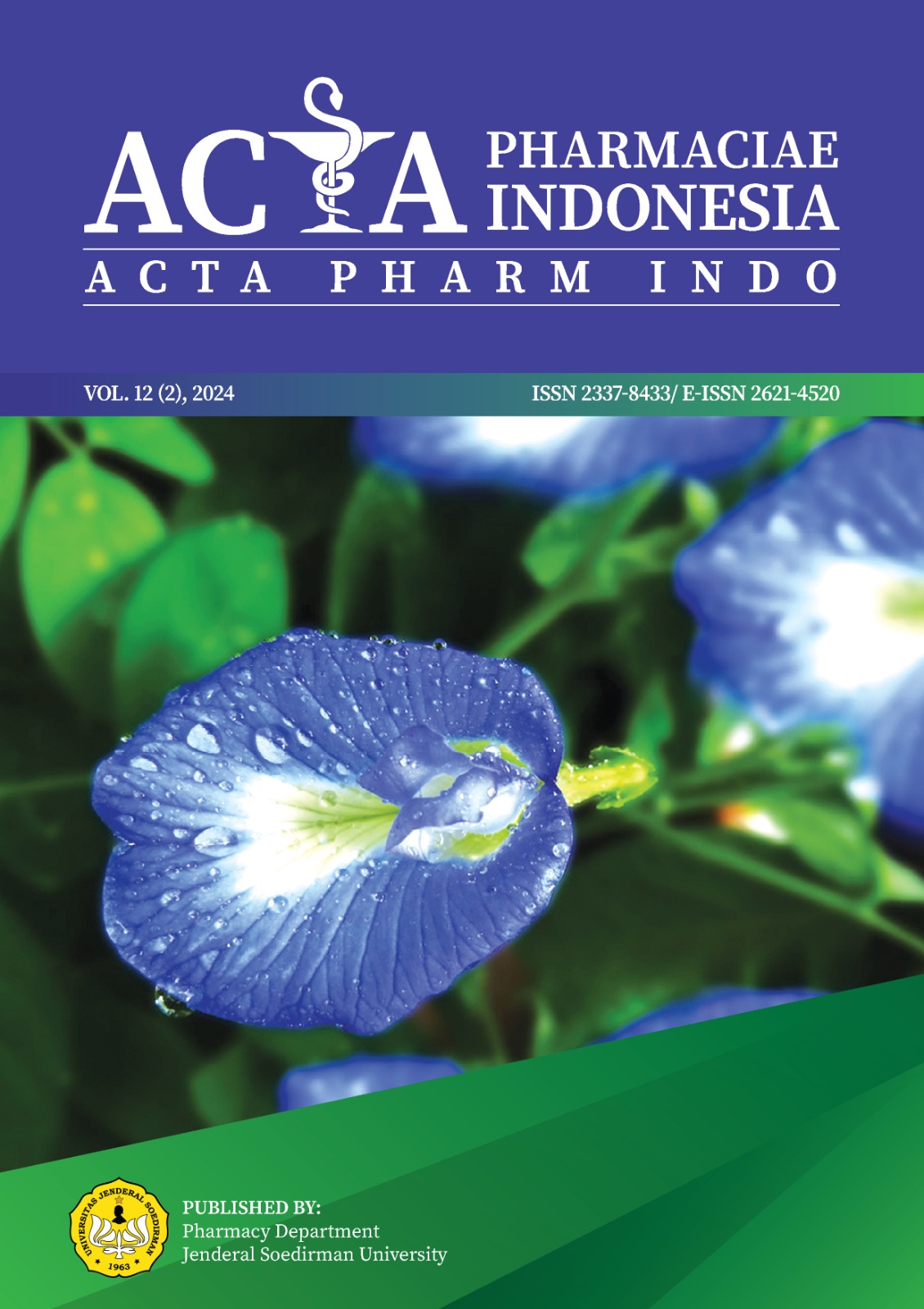Enzymatic hydrolysis of chicken feet for bioactive peptides: method validation and protein quantification
Abstract
Background: Stunting affects 21.5% of Indonesian children under five, primarily due to chronic nutritional deficiencies. Chicken feet, underutilized poultry byproducts rich in protein, represent potential sources of bioactive peptides for nutritional interventions.
Objective: This study evaluated two enzymatic hydrolysis methods for producing bioactive peptides from chicken feet and validated analytical methods for protein quantification.
Methods: Chicken feet were hydrolyzed using bromelain and sequential papain-alcalase treatments. Soluble proteins were quantified using the Biuret assay. Analytical methods were validated for accuracy, precision, and linearity according to ICH guidelines.
Results: The analytical method demonstrated satisfactory performance with accuracy values of 98-102%, RSD values below 2%, and linearity (R² = 0.9977) across the 3-11 mg/mL range. Bromelain treatment significantly increased soluble protein content to 24.39 ± 0.65 mg/mL, representing a 1.71-fold increase compared to the non-hydrolyzed control (14.24 ± 0.20 mg/mL, p < 0.001). Conversely, papain-alcalase treatment decreased soluble protein content to 10.92 ± 0.05 mg/mL, likely due to excessive peptide degradation into free amino acids undetectable by the Biuret assay.
Conclusion: Bromelain hydrolysis demonstrated superior protein solubilization efficiency compared to papain-alcalase treatment. These preliminary findings suggest bromelain’s potential for converting chicken feet into functional ingredients, though further peptide characterization and bioactivity assessment are required for nutritional applications.
References
2. Tim Percepatan Penurunan Stunting. TP2S - Tim Percepatan Penurunan Stunting. 2024 Nov 21 [cited 2024 Nov 21]. Available from: https://stunting.go.id/
3. Fikawati S, Syafiq A, Ririyanti RK, Gemily SC. Energy and protein intakes are associated with stunting among preschool children in Central Jakarta, Indonesia: a case-control study. Mal J Nutr. 2021 Mar;27(1):081–91. https://doi.org/10.31246/mjn-2020-0074
4. Widyawardani N, Bustamam N, Aprilia CA, Hardini N, Prasetio PO, Yusuf KN, et al. Analysis of macronutrient and micronutrient intake with the incidence of stunting and wasting in toddlers 0-59 months of age at public health center Bojong, Bogor regency. World Nutr J. 2024 Feb;7(i2):i2. https://doi.org/10.25220/WNJ.V07.i2.0010
5. Elisanti AD, Jayanti RD, Amareta DI, Ardianto ET, Wikurendra EA. Macronutrient intake in stunted and non-stunted toddlers in Jember, Indonesia. J Public Health Res. 2023 Jul;12(3):22799036231197178. https://doi.org/10.1177/22799036231197178
6. Badan Pusat Statistik Indonesia. Rata-rata Konsumsi Perkapita Seminggu Menurut Kelompok Bahan Makanan Lainnya Per Kabupaten/kota - Tabel Statistik. 2024 Mar 13 [cited 2024 Mar 13]. Available from: https://www.bps.go.id/id/statistics-table/2/MjEwNiMy/rata-rata-konsumsi-perkapita-seminggu-menurut-kelompok-bahan-makanan-lainnya-per-kabupaten-kota.html
7. Ozturk-Kerimoglu B, Heres A, Mora L, Toldrá F. Antioxidant peptides generated from chicken feet protein hydrolysates. J Sci Food Agric. 2023;103(14):7207–17. https://doi.org/10.1002/jsfa.12802
8. Bravo FI, Mas-Capdevila A, Margalef M, Arola-Arnal A, Muguerza B. Novel Antihypertensive Peptides Derived from Chicken Foot Proteins. Mol Nutr Food Res. 2019 Jun;63(12):e1801176. https://doi.org/10.1002/mnfr.201801176
9. Casanova-Martí À, Bravo FI, Serrano J, Ardévol A, Pinent M, Muguerza B. Antihyperglycemic effect of a chicken feet hydrolysate via the incretin system: DPP-IV-inhibitory activity and GLP-1 release stimulation. Food Funct. 2019 Jul;10(7):4062–70. https://doi.org/10.1039/C9FO00695H
10. Mas-Capdevila A, Iglesias-Carres L, Arola-Arnal A, Suarez M, Muguerza B, Bravo FI. Long-term administration of protein hydrolysate from chicken feet induces antihypertensive effect and confers vasoprotective pattern in diet-induced hypertensive rats. J Funct Foods. 2019 Apr;55:28–35. https://doi.org/10.1016/j.jff.2019.02.006
11. Akbarian M, Khani A, Eghbalpour S, Uversky VN. Bioactive Peptides: Synthesis, Sources, Applications, and Proposed Mechanisms of Action. Int J Mol Sci. 2022 Jan;23(3):3. https://doi.org/10.3390/ijms23031445
12. Zaky AA, Simal-Gandara J, Eun JB, Shim JH, Abd El-Aty AM. Bioactivities, Applications, Safety, and Health Benefits of Bioactive Peptides From Food and By-Products: A Review. Front Nutr. 2022 Jan;8:815640. https://doi.org/10.3389/fnut.2021.815640
13. BIOPEP-UWM - Katedra Biochemii Żywności. 2024 Mar 13 [cited 2024 Mar 13]. Available from: https://biochemia.uwm.edu.pl/en/biopep-uwm-2/
14. Sabrina N, Rizal M, Nurkolis F, Hardiansyah H, Tanner MJ, Gunawan WB, et al. Bioactive peptides identification and nutritional status ameliorating properties on malnourished rats of combined eel and soy-based tempe flour. Front Nutr. 2022 Sep;9:963065. https://doi.org/10.3389/fnut.2022.963065
15. Salindeho N, Mokolensang JF, Manu L, Taslim NA, Nurkholis F, Gunawan WN, et al. Fish scale rich in functional compounds and peptides: A potential nutraceutical to overcome undernutrition. Front Nutr. 2022 Dec;9:1072370. https://doi.org/10.3389/fnut.2022.1072370
16. Zaky AA, Simal-Gandara J, Eun JB, Shim JH, Abd El-Aty AM. Bioactivities, Applications, Safety, and Health Benefits of Bioactive Peptides From Food and By-Products: A Review. Front Nutr. 2022 Jan;8:815640. https://doi.org/10.3389/fnut.2021.815640
17. Jakubczyk A, Karaś M, Rybczyńska-Tkaczyk K, Zielińska E, Zieliński D. Current Trends of Bioactive Peptides-New Sources and Therapeutic Effect. Foods. 2020 Jul;9(7):7. https://doi.org/10.3390/foods9070846
18. Selamassakul O, Laohakunjit N, Kerdchoechuen O, Yang L, Maier CS. Bioactive peptides from brown rice protein hydrolyzed by bromelain: Relationship between biofunctional activities and flavor characteristics. J Food Sci. 2020 Mar;85(3):707–17. https://doi.org/10.1111/1750-3841.15052
19. Ahmad Nadzri FN, Tawalbeh D, Sarbon NM. Physicochemical properties and antioxidant activity of enzymatic hydrolysed chickpea (Cicer arietinum L.) protein as influenced by alcalase and papain enzyme. Biocatal Agric Biotechnol. 2021 Sep;36:102131. https://doi.org/10.1016/j.bcab.2021.102131
20. Trang CH, Le DTC, Lieu DT, Minh PQ. Determination of total protein content in biologicals using biuret method. jcvb. 2021;1(1+2):118–30. https://doi.org/10.56086/jcvb.vi1.13
21. Suhendi A, Rohman A, Cahyaningrum S. Validasi Metode Analisis Penetapan Kadar Protein Ekstrak Ikan Gabus dengan Metode Lowry dan Bromocresol Green. J Kefarm Indones. 2023 Feb;13(1):50–8. https://doi.org/10.22435/jki.v13i1.6219
22. Bradauskiene V, Vaiciulyte-Funk L, Cernauskas D, Dzingelevivinene R, Lima JPM, Braudauskaite A, et al. The Efficacy of Plant Enzymes Bromelain and Papain as a Tool for Reducing Gluten Immunogenicity from Wheat Bran. Processes. 2022 Oct;10(10):10. https://doi.org/10.3390/pr10101948

This work is licensed under a Creative Commons Attribution 4.0 International License.


1.png)








